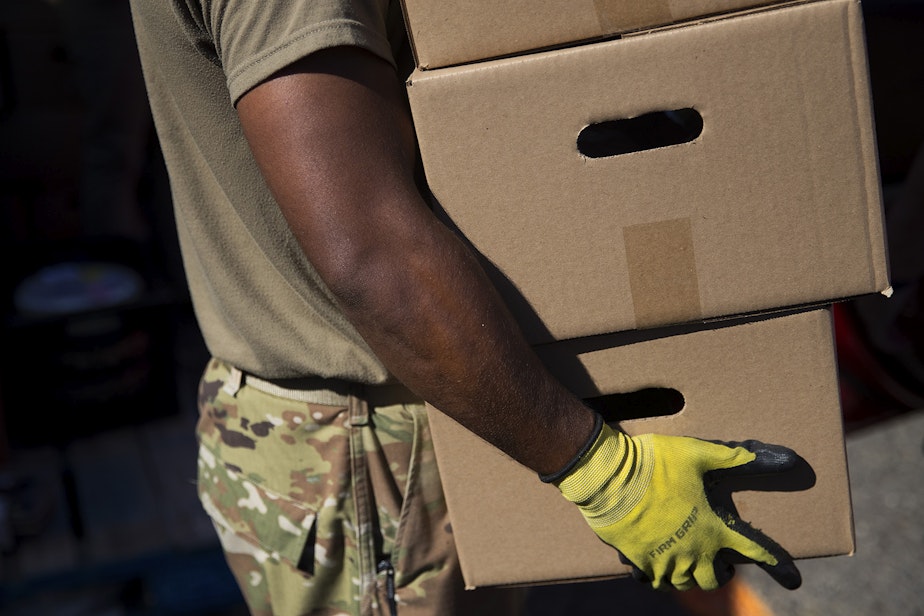Ways to give amid spiking food insecurity: money, food, time

As we head into the holidays during this third wave of coronavirus, here's another reminder that the pandemic is hitting many of us in multiple ways.
A recent study found that nearly one third of Washington households have struggled at some point since the start of the pandemic with having enough to eat. Of those families, 59% had children living at home.
Katie Rains is a policy advisor to the director of the Washington State Department of Agriculture. She serves on Gov. Jay Inslee’s Food Security Coordination Team.
This interview has been edited for clarity.
We know this pandemic has hit the economy hard. Can you describe the magnitude of the need that you're seeing now?
It has been a really challenging year for families across Washington for so many reasons, but certainly because of the economic impact, and not having enough access to food. Last year, 1.1 million Washingtonians had turned to a food pantry for hunger relief and food assistance. This year, we expect that that number has doubled to 2.2 million, or approximately a third of our state.
Was there a moment when you were looking at the data, or speaking to a partner from a food bank or another agency, and you thought, "Okay, this is now reaching a new level of serious?"
I think that we were pretty shell-shocked in March, even at the very end of March, and it really hasn't changed. It's only gotten worse, in some respects, after the enhanced federal unemployment went away in August.
I never imagined in a million years that part of my role would be to help deploy National Guard to keep hunger relief organizations open, as they had to safely keep their volunteers at home, many of whom are older adults (and) are in higher risk groups.
Some other examples: I know of food banks that used to see 150 clients a week who are now seeing 1,000 in rural East Pierce County; organizations up in Skagit. County that used to have one distribution site that now operate 17, in part because of growing need, and in part because the folks who used to operate those food pantry sites are older adults who needed to stop doing that service for the year.
Katie, how is state government responding to this?
State government has been working hard to coordinate between agencies, as well as with FEMA, the State Emergency Operations Center, and the largest nonprofit food banks in the state to plan and prepare and pool all of our resources to make sure that everyone's needs are getting met to the very best of our ability.
Our procurement team, because this isn't something born of statute and isn't something that we've traditionally provided, when they started doing purchasing— it's a team of five folks at WSDA — one of the team's guiding principles throughout this purchasing period is "Would I feed this to my family?" If the answer was no, we let it pass. If the answer was yes, we bought it, assuming that we could get the price point that would be the best use of our resources, and the greatest stewardship of taxpayer dollars.
For people who are listening who want to help, what would have the most impact?
There are a few ways that folks can help. Gov. Inslee, in partnership with All In Washington, earlier this year launched the Washington Food Fund. If folks donate to that fund online, the donations will be received by the three largest food banks in the state. That's Northwest Harvest, Food Lifeline, and Second Harvest. Those organizations combined are providing food and services to every single county in the state, as well as tribes.
If you want to connect locally, and you have additional funds that you could share, then certainly reach out to your local food bank. Find out if they're doing a food drive and go purchase food for them to meet the goals of that drive, or make a cash donation.
If money isn't what you have, but perhaps you have time right now, another huge thing, especially if you're in a lower risk group, would be to consider volunteering. Reach out to your local hunger relief organization. Find out if they're accepting volunteers right now. Not just food banks need support right now, but Meals on Wheels in particular. Senior service programs across the state have had to address a huge increase in need as seniors in particular were asked to stay home very early on, and that hasn't lifted all year.
Helping get food to folks in need can come in a variety of forms. Maybe that's money, or maybe that's food. Maybe that's just donating your time, and helping get it out there.
Listen to the interview by clicking the play button above.


